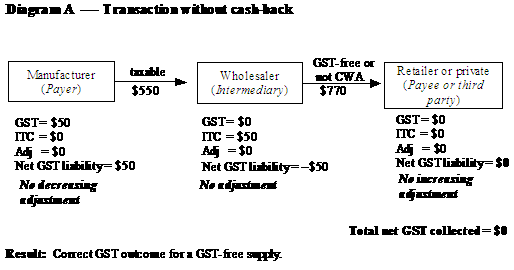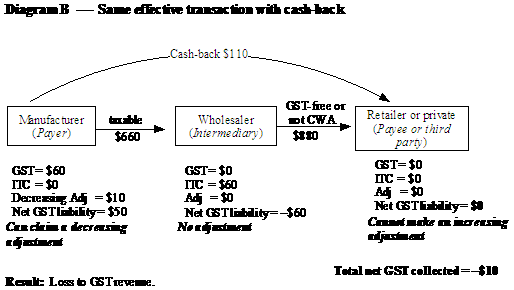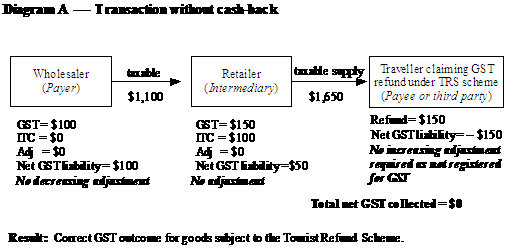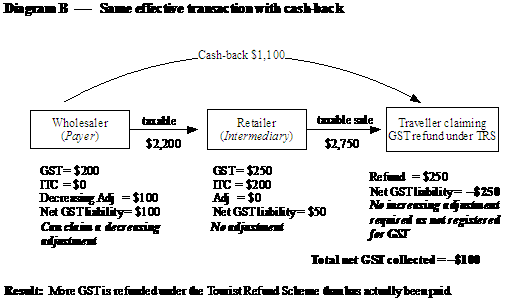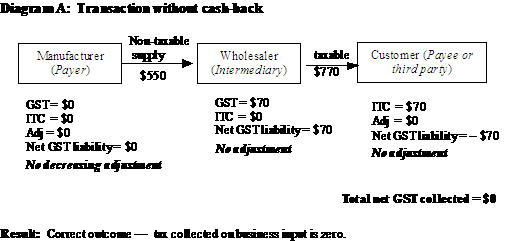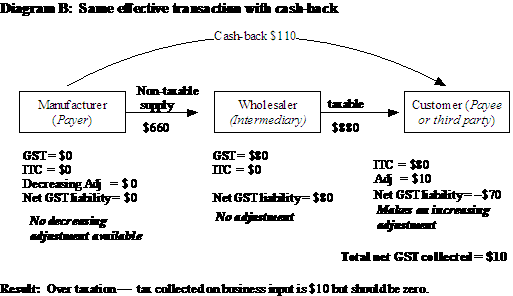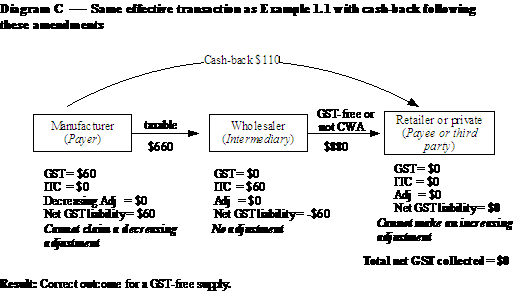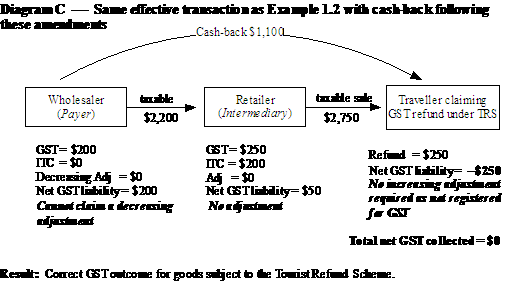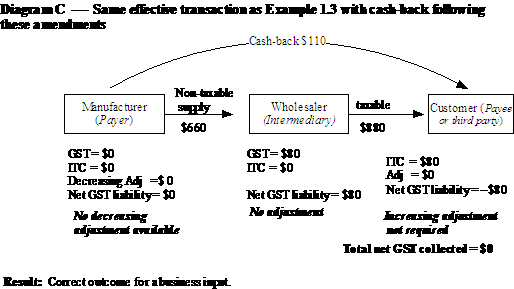Explanatory Memorandum
(Circulated by the authority of the Deputy Prime Minister and Treasurer, the Hon Wayne Swan MP)Chapter 1 - GST amendments to third party payment adjustment provisions
Outline of chapter
1.1 Schedule 1 to this Bill amends the A New Tax System (Goods and Services Tax) Act 1999 (GST Act) to ensure the third party payment adjustment provisions operate appropriately where there are third party payments relating to a supply by the payer that is not taxable or a supply to the payee that is goods and services tax (GST)-free, not connected with Australia or subject to a GST refund under the Tourist Refund Scheme.
Context of amendments
1.2 Where a registered entity supplies a thing to another entity (intermediary) and that intermediary on sells that thing to a third party, the original supplier of the thing (the payer), sometimes makes a payment (a third party payment), to the third party (the payee). Under Division 134 (that is, the third party payment adjustment provisions), which comes into effect on 1 July 2010, the payer remits GST based on the price for which it sells the thing to the intermediary but can also claim a decreasing adjustment for the third party payment. If the payee is a registered entity, it is required to make an increasing adjustment to reflect the effective decrease in the consideration paid for the thing. No increasing adjustment arises if the payee is not registered for GST. The net outcome should be that the appropriate amount of GST is collected throughout the supply chain - that is, in the case of taxable supplies, one-eleventh of the final (GST-inclusive) purchase price.
1.3 The third party payment adjustment provisions can result in inappropriate outcomes where the supply by the payer to another entity is taxable but the eventual supply to the payee is GST-free (such as exports or pharmaceuticals), or not connected with Australia (such as sales by an overseas retailer to its customers overseas). If third party payments are made and a decreasing adjustment is claimed, the net GST payable through the supply chain may be negative for supplies that should have a net GST amount of zero over the supply chain.
1.4 By increasing the price charged to an interposed entity but using rebates to maintain the same price to the payee, a payer could use the payment of rebates to produce a more favourable GST outcome, thereby obtaining an advantage over competitors who were paying an appropriate amount of GST. This is shown in Example 1.1.
Example 1.1 : Impact of third party payment adjustments on GST outcomes where supply to the payee is GST-free or not connected with Australia
CWA: connected with Australia
ITC: input tax credit
In this example in Diagram A, the manufacturer is originally making supplies to the wholesaler for $550. As the supply is a taxable supply the manufacturer remits GST of $50. The wholesaler adds a $220 margin and sells the items to their customer (who may or may not be registered for GST) for $770. The supply by the wholesaler to its customer is GST-free so no GST is remitted and the wholesaler has an input tax credit of $50. Hence no net GST is collected on the supply - the appropriate outcome for a GST-free supply.
In Diagram B, the manufacturer now pays a $110 rebate to the final customers and covers this cost by increasing the price to the wholesaler by $110 to $660. The manufacturer has a GST liability of $60 in relation to the supply but is also entitled to a $10 decreasing adjustment in relation to the rebate so their net GST liability is $50. As the wholesaler acquires the items for $660 it has an input tax credit of $60. As before, it adds a margin of $220 and sells the items to its customers for $880. The effective price to these customers remains $770 due to the rebate received from the manufacturer. The net GST on the supply is a loss to the revenue of $10.
1.5 The third party payment adjustment provisions can also result in inappropriate GST outcomes where the supply to the payee is subject to a refund of GST under the Tourist Refund Scheme, as this has a similar outcome to where the supply is GST-free. By increasing the price charged to an interposed entity but using rebates to maintain the same price to a payee who was eligible to obtain a refund of GST under the Tourist Refund Scheme, a payer could use the payment of rebates targeted specifically to those customers to produce a more favourable GST outcome in this situation, thereby obtaining an advantage over competitors who were paying an appropriate amount of GST.
1.6 This is shown in Example 1.2.
Example 1.2 : Impact of third party payment adjustments on GST outcomes where supply to the payee is eligible for a GST refund under the Tourist Refund Scheme
ITC: input tax credit
In this example in Diagram A, the wholesaler is originally making a supply of an opal ring to a retailer for $1,100. As the supply is a taxable supply the wholesaler remits GST of $100. The retailer adds a $550 margin and sells the items to their customer (who is not registered for GST) for $1,650. The retailer has a GST liability of $150 and an input tax credit of $100 so it remits net GST of $50. A total of $150 of GST has been remitted in respect of the ring. The purchaser presents the ring and their tax invoice on leaving Australia and receives a refund of $150 under the Tourist Refund Scheme. Effectively no net GST is collected on the supply - the appropriate outcome for a supply subject to a refund of GST under the Tourist Refund Scheme.
In Diagram B, the wholesaler now pays a $1,100 rebate to the final customer and covers this cost by increasing the price to the retailer by $1,100 to $2,200. The wholesaler has a GST liability of $200 in relation to the supply but is also entitled to a $100 decreasing adjustment in relation to the rebate so its net GST liability is $100. As the retailer acquires the items for $2,200 it has an input tax credit of $200. As before, the retailer adds a margin of $550 and sells the items to its customers for $2,750. It has a GST liability of $250 and an input tax credit entitlement of $200 so remits net GST of $50. The total GST collected in respect of the ring is $150 and the effective price to the customers is $1,650 due to the $1,100 rebate received from the wholesaler. However, the purchaser presents the ring and their tax invoice on leaving Australia and receives a refund of $250 under the Tourist Refund Scheme. The effective net GST on the supply is a loss to the revenue of $100.
1.7 It is also possible for there to be an inappropriate outcome where the initial supply by the payer is not taxable but the final supply is taxable. In these cases, if an increasing adjustment were to apply to the payee receiving the third party payment, too much GST would be remitted through the supply chain. This is shown in Example 1.3.
Example 1.3 : Impact of third party payment adjustments on GST outcomes where supply by the payer is non-taxable but supply to the payee is a creditable acquisition
ITC - input tax credits
In this example a manufacturer sells wheelchairs to a wholesaler as a GST-free supply. Normally, when the manufacturer on sells the wheelchairs they remain GST-free. However, the wholesaler sells some of those wheelchairs to an airline which uses them as an input into making taxable supplies - that is, the supply of travel services to its customers. To simplify its GST reporting, the airline has agreed with the wholesaler that these supplies will be treated as taxable, which section 38-45 of the GST Act allows.
In Diagram A, the manufacturer originally makes the supply to the intermediary for $550. As this supply is a not a taxable supply the manufacturer does not remit GST. The wholesaler adds a $220 margin and sells the items to the airline (which is registered for GST) for $770. The supply by the wholesaler to the airline is treated as taxable so the wholesaler remits GST of $70 and has no input tax credit. The acquisition of the wheelchairs by the airline is a creditable acquisition so an input tax credit of $70 is claimed. Hence no net GST is collected on the supply of the wheelchairs to the airport, which is the appropriate outcome for a business input.
In Diagram B, the same effective transaction is taking place but the manufacturer is paying a $110 rebate to the final customers and the price it charges the wholesaler is $660. As the sale to the wholesaler is not a taxable supply, the manufacturer has no GST liability and is not entitled to a decreasing adjustment in relation to the rebate, so its net GST liability is $0. The wholesaler acquires the items for $660 and has no input tax credit entitlement. As in Diagram A, it adds a margin of $220 and sells the items to its customers for $880. The effective price to its customers is $770 due to the rebate received from the manufacturer. As the supply to the airline is treated as a taxable supply the wholesaler has a GST liability of $80. The airline has a corresponding input tax credit of $80 but is required to make an increasing adjustment of $10. As a result there is $10 of embedded GST through the supply chain on these business inputs.
Summary of new law
1.8 From 1 July 2010 third party payment adjustments will not arise where there are payments which would give rise to such adjustments, but the supply by the payer is not taxable or the supply to the payee is GST-free, not connected with Australia or subject to a GST refund under the Tourist Refund Scheme.
| New law | Current law |
| A decreasing third party payment adjustment does not arise if the supply to the payee by an intermediary is a GST free supply, is not connected with Australia or is subject to a GST refund under the Tourist Refund Scheme and the payer knows or has reasonable grounds to suspect this.
An increasing third party payment adjustment does not arise if the supply by the payer to an intermediary is not a taxable supply. |
A decreasing third party payment adjustment arises if the payer of the third party payment makes a taxable supply to an intermediary and the supply from an intermediary to the payee is a GST free supply, is not connected with Australia or is subject to a GST refund under the Tourist Refund Scheme.
An increasing third party payment adjustment arises if the acquisition by the payee from the intermediary is a creditable acquisition and the supply by the payer to an intermediary is not a taxable supply. |
Detailed explanation of new law
1.9 Subsection 134-5(1A) provides that a decreasing adjustment for a third party payment will not arise if the supply by an intermediary to the payee, which would otherwise give rise to such an adjustment, is a GST-free supply, is not connected with Australia or is subject to a refund of GST under the Tourist Refund Scheme, and the payer knows, or had reasonable grounds to suspect this.
1.10 In some cases the payer may have information from which it may conclude that a supply to the payee is likely to be GST-free, not connected with Australia or is subject to a refund under the Tourist Refund Scheme. For example, where the nature of the product is such that its final supply may be GST-free (such as pharmaceuticals), where the receipt provided by the payee indicates payment of a refund under the Tourist Refund Scheme or where the payee provides details to the payer to facilitate the payment which indicate that the payee is located outside of Australia. In these cases, the payer would have reason to suspect that the supply is GST-free, not connected with Australia or subject to a refund under the Tourist Refund Scheme. Accordingly, it could not make a decreasing adjustment, unless it takes steps which establish that the supply to the payee is not in fact a GST-free supply, a supply not connected with Australia or a supply for which the payee obtained a refund of GST under the Tourist Refund Scheme.
1.11 Where there are no circumstances that indicate to the payer that the supply to the payee may be GST-free, not connected with Australia or a supply subject to a refund of GST under the Tourist Refund Scheme, it is not intended that the supplier would need to make any specific inquiries to determine the GST treatment of the supply to the payee.
1.12 Subsection 134-10(1A) provides that an increasing adjustment for a third party payment will not arise if the supply to an intermediary by the payer, which would give rise to such an adjustment, is not a taxable supply.
1.13 However, paragraph 134-10(1A)(b) provides that where the supply to an intermediary by the payer, is not a taxable supply only because the payer and the intermediary are members of the same GST group, or GST religious group, or the payer is the joint venture operator for a GST joint venture and the intermediary is a participant in the GST joint venture, the increasing adjustment will nevertheless arise.
1.14 The following examples show the impact of these amendments on the situations outlined in the previous examples.
Example 1.4 : Impact of the new law on GST outcomes where supply to the payee is GST-free or not connected with Australia
CWA - connected with Australia
ITC - input tax credits
In Diagram C, the manufacturer pays a $110 rebate to the final customers and covers this cost by increasing the price to the wholesaler by $110 to $660. The manufacturer has a GST liability of $60 in relation to the supply but, because the supply to the payee is a GST-free supply and it knows or has reason to expect this, it is not entitled to a decreasing adjustment in relation to the rebate so its net GST liability is $60. As the wholesaler acquires the items for $660 it has an input tax credit of $60. The net GST collected on the supply over the supply chain is zero - the correct outcome for a GST-free supply.
Example 1.5 : Impact of the new law on GST outcomes where supply to the payee is subject to a GST refund under the Tourist Refund Scheme
ITC - input tax credits
TRS - Tourist Refund Scheme
In this scenario a wholesaler introduces a cash-back arrangement that is targeted at tourists who are about to travel overseas. The tourists are required to provide a copy of their tax invoice, which is stamped as having received a refund under the Tourist Refund Scheme. As the wholesaler is aware that the supply to the payee is subject to a refund under the Tourist Refund Scheme the decreasing adjustment is not available to the payer.
However, there may be circumstances in which the payer would not know, nor could they reasonably be expected to know, that a supply to a payee was subject to a refund under the Tourist Refund Scheme. For example, a distributor of laptop computers may offer a rebate on sales of a soon to be superseded line of laptops to end customers. They are sold through a range of retail outlets. Customers are able to claim the rebate by sending a copy of their receipt together with details such as a postal address or a bank account number to the distributor to enable payment to be made. If the purchaser supplied a copy of the receipt together with an Australian address or Australian bank account number, the distributor would not be expected to consider that the supply had been subject to a claim under the Tourist Refund Scheme.
If the copy of the receipt provided, showed that the receipt had been stamped as being subject to a refund under the Tourist Refund Scheme, the distributor would know this. If the address or bank details provided were not for an Australian address or an Australian bank, the distributor would need to ascertain whether the supply to the payee was subject to a refund under the Tourist Refund Scheme before claiming a decreasing adjustment in respect of the rebate.
1.15 Example 1.6 shows the impact of these amendments in situations where the supply by the payer is not a taxable supply.
Example 1.6 : Impact of the new law on GST outcomes where supply by the payer is non-taxable but supply to the payee is a creditable acquisition
ITC - input tax credits
In this scenario the airline can establish, by reference to the nature of the goods and its agreement with the wholesaler to treat the supply of the wheelchairs as a taxable supply, that the supply by the payer to an intermediary was not a taxable supply. Consequently the airline is not required to make an increasing adjustment with regard to the rebate it receives from the payer. As before, the wholesaler has a GST liability of $80 and the airline has a corresponding input tax credit of $80. Zero GST is collected through the supply chain to that point, which is the correct outcome for a business input.
Application and transitional provisions
1.16 These amendments apply to third party payments made on or after 1 July 2010, which is the date on which third party payment adjustment provisions contained in Division 134 of the GST Act take effect.

